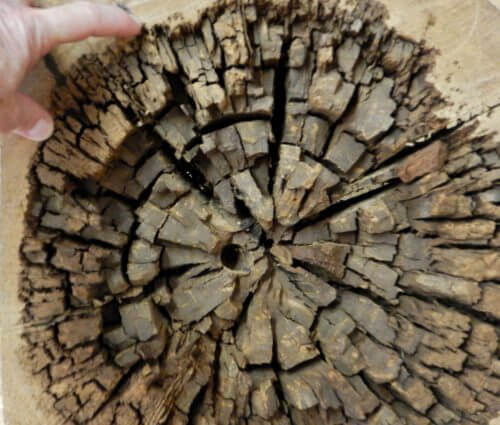Researchers from the University of Massachusetts reveal the exact mechanism by which brown root fungi succeed in breaking down wood biomass, without the use of enzymes.
![Brown root mushrooms (Gloeophyllum sepiarium) [Courtesy: Karel Tejkal]](https://www.hayadan.org.il/images/content3/2017/09/Photo-1.-Karel-Tejkal-500x318.jpg)
About twenty years ago, the microbiologist Barry Goodell, who is now a professor at the University of Massachusetts, and his colleagues, discovered a unique system in which several types of microorganisms are used to digest and recycle wood. Today, there are already three varieties of brown root fungi that are capable of breaking down biomass, but the details of the mechanism of this breaking down were not known until today.
Now, the researchers report new details about this unexpected mechanism, which surprisingly does not involve the activity of enzymes, the usual catalysts used in chemical reactions in biological systems. Instead, these fungi make use of non-enzymatic biocatalysis, based on chelators (trapping substances) which is "completely different from mechanisms found in any other microorganism studied so far", explains the lead researcher. Chelators are organic compounds that bind to metal ions, and in this case, they also produce hydroxyl radicals, which promote the decomposition of wood while obtaining simple chemicals that can be used as building blocks for the synthesis of more complex substances. The research findings, which constitute a sensational discovery in the field of biocatalysis of fungi that enable the conversion of biomass, appear in the latest issue of the scientific journal Biotechnology for Biofuels. Explains the lead researcher: "Our research on mushroom bioconversion systems revealed an innovative mechanism that could be used in the future in biological refineries designed to break down tree biomass to obtain simpler chemicals that could be used to produce biopolymers and energy products."
Brown root fungi occur in both the northern and southern hemispheres and are among the most common rot fungi in North America. Since this species evolved relatively recently, there are fewer varieties of brown root mushrooms compared to white root mushrooms. "At the same time, in light of their ability to efficiently decompose wood, brown root fungi have become the dominant species, especially in the decomposition of softwoods," explains the lead researcher, as this species is currently responsible for approximately eighty percent of the recycling of carbon from the source of softwood biomass in the world, which are mainly In the mighty forests of the Northern Hemisphere.

The researchers point out that most microorganisms use enzymes to break down compounds, but enzymes are huge molecules that require the use of a lot of energy for their production, due to their high nitrogen content. "Until today, scientists believed that these fungi create holes in the cell wall and thereby allow large enzymes to enter the cell. However, as we discovered, the mechanism is completely different." "The fungi we studied use a non-enzymatic catalytic system based on chelators as part of a simple process that utilizes hydrogen peroxide generated inside the fungi along with iron found in the environment," says the lead researcher. He explains: "This family of brown root fungi managed to develop a mechanism by which they create hydroxyl radicals away from the cells themselves, radicals that break down the tree. Hydroxyl radicals have great potential for cellular damage, and are considered the most powerful oxidants known in biological systems.
The researchers add and point out that these fungi do produce a limited number of enzymes, but these perform their activity only after the end of the non-enzymatic mechanism. The chelators are secondary metabolites, and studying their function using standard genomic methods is particularly challenging. "With the help of many advanced methods," explains the researcher, "we were able to identify extremely small compounds that enter the cells through the wall. This family of fungi has evolved in a way that allows them to break down the substrate of the trees, first by introducing chelators into the cell walls and then producing hydrogen peroxide from oxygen, and together breaking down the cell walls to obtain the sugar that is the basic building block of the tree, glucose, in which the fungi can use as fuel. In this way, these fungi digest, and in the end also completely decompose, the wood", explains the main researcher.

One response
interesting,
Only the translation is flawed, it says: "three varieties of mushrooms",
In the original it is written "Three orders of brown rot fungi" meaning three series,
orders = series,
In sorting there are series, families, genera, species or subspecies,
Yuk varieties!
Later it is written in the source "This group of fungi" meaning in this group,
For some reason the translator writes sex, which adds to the confusion
When referring to mushrooms in which there are hundreds of types and thousands of species
should be precise in the translation,